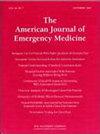The role of peripheral perfusion index in predicting biphasic reactions in anaphylaxis patients
IF 2.7
3区 医学
Q1 EMERGENCY MEDICINE
引用次数: 0
Abstract
Background/aim
Anaphylaxis is a rapidly onset, life-threatening hypersensitivity reaction, and in some patients, a biphasic reaction may develop following initial treatment. This study aims to investigate the prognostic value of the peripheral perfusion index (PPI) in predicting biphasic reactions among patients presenting to the emergency department with anaphylaxis.
Material and methods
The study is prospective and single-centered. A total of 104 patients aged 18 years and older, diagnosed with anaphylaxis in the emergency department, were included. PPI values, along with other vital signs, were measured at 0, 10, 20, and 30 min, as well as after symptom resolution. All patients were observed for a minimum of 6 h to monitor for the development of biphasic reactions.
Results
The median PPI value at the 0-min mark was 2.20 (IQR, 1.52–3.67), while the median PPI value after symptom resolution was 4.20 (IQR, 3.10–6.35). A biphasic reaction occurred in 10.6 % of patients. Among patients who developed a biphasic reaction, PPI values at 0, 10, 20, and 30 min were significantly lower compared to those who did not (p < 0.05). In ROC analysis, a PPI cutoff of ≤2.17 for predicting biphasic reactions yielded 57 % sensitivity and 91 % specificity (AUC = 0.75).
Conclusion
PPI may serve as an accessible and cost-effective test in emergency departments for continuous monitoring of patients diagnosed with anaphylaxis, allowing for assessment of treatment response, early detection of biphasic reactions, and risk evaluation.
外周灌注指数在预测过敏反应患者双相反应中的作用
背景/目的:过敏性反应是一种发病迅速、危及生命的超敏反应,在一些患者中,初始治疗后可能出现双相反应。本研究旨在探讨外周灌注指数(PPI)在预测急诊过敏反应患者双相反应中的预后价值。材料与方法本研究为前瞻性、单中心研究。共纳入104例年龄在18岁及以上,在急诊科诊断为过敏反应的患者。在0、10、20和30分钟以及症状缓解后测量PPI值以及其他生命体征。所有患者至少观察6小时,以监测双相反应的发展。结果0 min时PPI中位数为2.20 (IQR, 1.52 ~ 3.67),症状消退后PPI中位数为4.20 (IQR, 3.10 ~ 6.35)。10.6%的患者出现双相反应。在发生双相反应的患者中,PPI值在0、10、20和30分钟显著低于未发生双相反应的患者(p <;0.05)。在ROC分析中,预测双相反应的PPI截止值≤2.17,敏感性为57%,特异性为91% (AUC = 0.75)。结论ppi可作为急诊科对诊断为过敏反应的患者进行持续监测、评估治疗效果、早期发现双相反应和风险评估的一种可获得且具有成本效益的检测方法。
本文章由计算机程序翻译,如有差异,请以英文原文为准。
求助全文
约1分钟内获得全文
求助全文
来源期刊
CiteScore
6.00
自引率
5.60%
发文量
730
审稿时长
42 days
期刊介绍:
A distinctive blend of practicality and scholarliness makes the American Journal of Emergency Medicine a key source for information on emergency medical care. Covering all activities concerned with emergency medicine, it is the journal to turn to for information to help increase the ability to understand, recognize and treat emergency conditions. Issues contain clinical articles, case reports, review articles, editorials, international notes, book reviews and more.

 求助内容:
求助内容: 应助结果提醒方式:
应助结果提醒方式:


